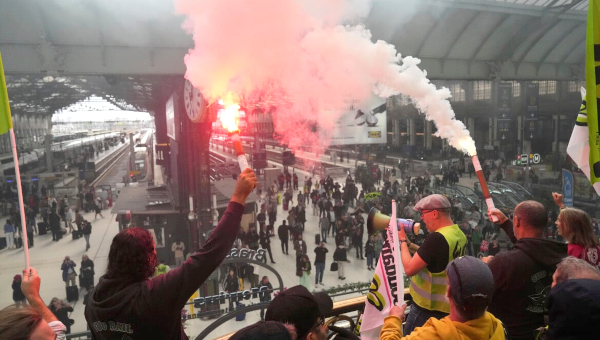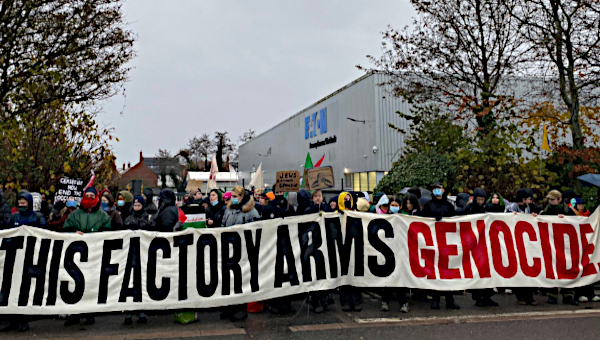The Electro-Motive Lockout and Non-Occupation
What did we lose? What can we learn?
Along with everything else, the 2008 financial crisis and its aftermath created new openings and potentials for working people in the struggle against neoliberalism. A number of struggles initially opened up, including factory occupations, efforts to defend pensions and the rights of younger workers. There were important political struggles, as well, as in Wisconsin, along with newer projects to link labour and communities, in the Occupy movement.
But this has to be placed in the context of the dramatic and ongoing pressure of restructuring, concessions bargaining and slack job markets in the private sector. While this has been an ongoing characteristic of the neoliberal period, the state-guided restructuring in auto, steel and other sectors have deepened a process which is still working itself through. Austerity budgets at all levels of government and political attacks have targeted public sector works, as well. The current moment is a rather bleak one for unionized workers in Canada.

This is the political setting that has driven a number of recent conflicts in Canada, most notably the Caterpillar (CAT) owned Electro-Motive Diesel (EMD) lockout and closure. This experience is particular to the changes in the larger transportation sector in North America. But it is also characteristic of the pressures facing the manufacturing industries, and therefore its unions and workers.
Electro-Motive – what happened?
By now, people have a certain familiarity with the events at EMD in London. Caterpillar, as part of its Progress Rail subsidiary, owns Electro-Motive. It was bought from two vulture funds that had previously purchased it from General Motors (GM) in 2005.1 The notorious anti-union company paid $820-million for EMD, which also includes an electronic manufacturing facility in LaGrange, Illinois. EMD is the only manufacturer of locomotive engines in Canada and the sale brought control over key technologies to CAT. Four months after the EMD sale, CAT announced plans to convert a factory in Muncie, Indiana into a union-free locomotive assembly plant.
In December, the company issued a final offer to its London workers that would cut hourly wages to $16.50 from $35.00 while slashing pensions and benefits, even though CAT enjoyed record profits and a 20 per cent boost to production over the previous year.2 The bargaining unit and local leadership refused and the company, revealing its general scorn for its employees, locked out its workers on New Year’s Day.
The union local, with the support of the National Canadian Auto Workers (CAW), began a campaign to isolate the employer, and demand that they bargain seriously and withdraw the demands. The Ontario Federation of Labour (OFL) called a “Day of Action” for January 21st, drawing attention to the failure of the Harper government to protect Canadian jobs and interests when domestic companies are acquired by foreign multi-nationals. The demonstration drew upwards of 5,000 people, but was little more than a rally. The union did not occupy the plant. [Ed.: see Bullet No. 586.]
February 3rd, after a month of campaigning, EMD publicly announced the impending closure. After a tense period, the union bargained a decent severance and closure package that the membership ratified on February 23rd.3
The closure of this facility in the face of the bullying by CAT is important – and will be addressed further in this article. But more important, is the nature of the resistance – and the limitations of the strategic approaches used. The EMD/CAT experience is an example of a gross attack by a ruthless employer on a group of union members. The ultimate goal was not to get a wage cut, but to set the stage for a workplace closure and, in the process, humiliate and defeat the union, thereby contributing another setback to the larger union movement. The union, CAW Local 27, refused to accept these outrageous demands and waged a locally-based campaign of resistance, on terms that traditionally would have meant something powerful, but in the current era, turned out to mean very little.
The tactics of resistance adopted were unsatisfactory. Although the worst did not happen – the ultimate outcome was decent severance, pensions and the like – it signalled both a serious defeat and a major opportunity lost. It resulted in a major defeat for the CAW, the rest of the labour movement and Canadian working-class. The workers lost their jobs. The message was sent to Canadian workers that in the face of threats to cut wages in half, you’d better not resist, or you’ll lose your jobs. Even more, the company and government were left off the hook for destroying key Canadian manufacturing skills and capacities and moving jobs to low-wage areas. The entire experience ended up deligitmating our potential to develop sectoral strategies and create openings for building a different kind of economy.
Background on Caterpillar/Electro-Motive Diesel
- $43-billion in sales, (2010)
- World’s largest manufacturer of construction and mining equipment;
- Went on expansion plan in 2009, cut costs; laid off 11,000 workers – 9 per cent of its workforce
- Even though it lost sales and revenues in the recession, its shares went up 64 per cent, best on Dow Jones in 2010; sales up in 2011, first 9 months, profits up 95 per cent;
- Outgoing CEO James Owens received $22.5-million for 6 months work and a Defined Benefit pension plan worth $18.7-million
- Broke the UAW in Peoria plant – CAW dealt with closure in Brampton, organized occupation in 1993;
- GE is its chief rival in locomotives;
- CAT built locomotive plants in Brazil, Mexico and Muncie, Indiana in the past year;
- In March 2008, Harper visited the EMD plant to show off a $5-million federal tax break for buyers of the locomotive-maker’s products and provided a further tax break on capital investment.
- Much has been written about the likelihood that CAT bought the EMD plant only to shut it down, as part of a plan to move the technology to the United States. Others have claimed that CAT owned the technology already.
There is little to celebrate out of this episode. It should be sobering, disheartening and a learning moment, about what not to do and what must be done to win in this era. In a union culture that is unable to deal with defeats and retreats and learn from them, where every challenge must end up appearing as ‘victory’ of sorts, it is difficult to learn lessons and use that learning to make change.
Finally, this is not something that is limited to the CAW. It is chronic throughout the Canadian labour movement and is reflected in the recent defeat of the CUPE municipal workers in Toronto, and the Steelworkers locals at Vale Inco and U.S. Steel in Hamilton as well as the ongoing struggle in Rio Tinto in Quebec (all of which had very different leadership structures and even ideological orientations).
What Were Some of the Larger Issues?
From the beginning, for union activists and working-class people, this struggle was seen as a continuation of new and dangerously aggressive attacks on the working-class in both the private and public sectors. It brought to mind key defeats: autoworker concessions in Canada and the U.S.; the loss of defined benefit pensions for Steelworker new hires; dramatic threats to the survival of unions for public sector workers in Wisconsin and other U.S. states. Even in Ontario, BC, and now through Harper’s Conservatives in Ottawa, attacks on unions threaten their very survival.
The terrain of current attacks is different in many ways. The companies take advantage of capital mobility made possible by free trade. They seem to be centred in employers that have been favoured by government, either through negotiated aid deals or other forms of support (and are usually related to larger, continent-wide restructuring strategies). The demands of the employer result in either the destruction or dramatic weakening of the union and a radical shift in the rights of the workers. They mark a new level of defeat for the labour movement and affect the willingness and capacity of workers to organize collective resistance. They undermine the rights of all working people – from those of us in the better paid jobs, to those of us out of work, on social assistance and in precarious jobs.
The attacks that EMD/CAT imposed on workers took this to another level.
The interest in CAT was, in a sense, a kind of culmination of the frustration that so many working-class people have had to live with in this era of the re-constitution of neoliberalism. It touched a nerve with many people. Even mainstream pundits critiqued the larger phenomenon of blackmail against working people (and saw in it, the reality in most workplaces these days). It also linked up with the Occupy narrative.
It was a living example of the de-industrialization process and the loss of key manufacturing capacities; of large mega-corporations, moving capital investment at will just to pressure working-class people to reduce living standards to accommodate private profit accumulation. It symbolized the threat to Canadian sovereignty and the survival of our communities that capitalism has become.
What Was Wrong With the Response to the EMD Lockout and Closure?
There are many issues to raise with the response of the CAW. Both the national and the local leaderships had limited horizons and goals. They saw themselves as addressing the immediate needs of the workers in the EMD unit: refusing to accept the threatened wage cuts, but planning for a plant closing that seemed inevitable. The plan was to build a base of community and labour support in the London area and the larger labour movement, get material support for the workers during the lockout period and then work to bargain severance and pension rights.4
Many of the political themes they raised were the right ones: corporate greed, the need to maintain manufacturing capacity, how the attacks on the workers contrasted with the wealth of the corporate elite and the 1 per cent, the role of Harper and efforts to have the rest of the CAW and the OFL support them. Their tactics and strategy reflected those goals. Their local campaign built widespread support across the London community. They engaged the provincial government behind the scenes to pressure CAT for pension and severance. They blockaded the movement of goods in and out of the workplace and began a campaign to place information pickets outside CAT outlets in southern Ontario.
Their goals and their strategy were limited and problematic. There was no move to occupy the workplace or extend and deepen the campaign to pressure Caterpillar, or raise political demands to pressure the Canadian government to stop an impending closure. They argued that ‘we didn’t want to turn people in the community off’, or threaten a possible close-out agreement.
The situation required a dramatic tactical move to politicize the struggle. A plant occupation, rather than ‘turning people off’ could have galvanized already-existing concerns of working people across the province and continent. It could have created an opening to call for state intervention – in the form of nationalizing EMD – as part of a larger project of building Canadian capacity to manufacture heavy transportation equipment, through the public sector.
 Instead, the perspective was local and short-term. There was little interest in making this a larger, political battle. The only political issue raised were challenges to the limitations of Investment Canada rules for assessing “net Canadian benefit” for a purchase by a foreign buyer of Canadian assets. There was blindness to the opening and opportunity that this universally condemned action by capital represented. It was almost if the union was content basking in the sun of public sympathy.
Instead, the perspective was local and short-term. There was little interest in making this a larger, political battle. The only political issue raised were challenges to the limitations of Investment Canada rules for assessing “net Canadian benefit” for a purchase by a foreign buyer of Canadian assets. There was blindness to the opening and opportunity that this universally condemned action by capital represented. It was almost if the union was content basking in the sun of public sympathy.
The idea of pressuring Harper for state intervention was seen as impossible and beyond the pale of what and who the union is. But working-class collective political action creates new openings, possibilities and capacities. An occupation could have concentrated interest and anger in London and created a platform to place nationalization on the public agenda, but this was the farthest thing from their sense of the possible. The tactic of occupation was portrayed as possibly threatening short-term interests of the workers at EMD. Aside from the narrowness and strategic incompetence this represented, it made the positive links the union built with the Occupy movement, rather hypocritical and embarrassing (ignoring the tactical and strategic audacity and originality of Occupy).
How Might a Different Kind of Campaign Proceeded?
The union could have expanded the campaign in London to include challenging government offices, banks, larger industrial employers, all of whom suddenly became ‘allies’ in the union’s perspective. It could have built a campaign across Southern Ontario – that might have included new and exciting educational materials and challenges to employers.
There could have been a boycott of CAT products around the Tar Sands and construction projects. There might have been a new education effort with the members so that they are no longer afraid of ‘turning off the rest of the community.’ Education turned the tide during the Ontario Days of Action in the 1990s, which relied on the organizational and educational capacities of many of the same local activists in London today to win over workers who had voted for Tory Mike Harris, to a protest movement against him. Where is the will and capacity to develop and build those mobilizational and educational resources today?
The CAW has had experience with bold campaigns that challenge employers and governments in the past. The 1997 contract bargained at GM successfully dealt with the issue of outsourcing. It was preceded by a strike and campaign waged by the union. In that campaign, the union was able to win over public opinion by appealing to common experiences in dealing with job insecurity. There were many workplace occupations in the early 1980s and late 1990s. True, they were mostly organized over demands for decent closeout agreements, but there is no reason that the tactic couldn’t also be used to be the central sparkplug for a larger campaign to keep a workplace open. The CAW has the institutional memory and capacities to carry out such a campaign.
This moment constituted ‘the critical opening’ to deal with the unspoken issues, underpinning the Occupy critique of the system. The moment was there to raise and answer challenging questions from workers in this current climate of austerity:
- Why should we accept the constant threats to jobs in the name of cost-reduction and competitiveness?
- Why should CEOs receive massive incomes, when we have to accept wage and benefit cuts?
- Why must we and our children ‘get used’ to the lack of good, secure, well-paying jobs, and instead, accept the normalization of part-time, low paid, precarious work? If workplaces like this are going to close without any alternative plan – what have we to look forward to?
There are other political issues that workers are posing that could also have and should have been raised as part of a fight to keep this workplace working. The questions here are many but they are central to the dialogue we need to rebuild our unions and develop alternatives to neoliberalism and capitalism.
- Why can’t we defend our right to produce locomotives in this country? Isn’t it central to our needs for political sovereignty? Isn’t it important for efforts to create a transportation system that is environmentally sustainable? What about mass transit investment for urban areas?
- While Harper continues to negotiate new Free Trade agreements, doesn’t the EMD closure create an opening for us to raise the call to challenge and ultimately abrogate existing agreements that allow the free movement of investment and capital unregulated by democratic institutions?
- Wasn’t Harper vulnerable on all of these points? His government intervened with the postal workers and repeatedly did so at Air Canada to supposedly protect the national interest. He was also seen to be in cahoots with CAT in his praise of subsidies to the employer. While the PM claimed that the EMD closure was between a union and a private employer and a matter of provincial jurisdiction, the hypocrisy of all of this made the federal government a legitimate target.
- Doesn’t it pose the question of the role and especially the limitations of the Investment Canada Act? The demands have been largely limited to soft nationalistic issues of foreign takeovers; getting tradeoffs for financial help to help foster investment and local, provincial or national procurement policies. Those are all important and positive. But, as in previous struggles, aren’t these demands too limited and won’t they leave us unable to address the larger issue of capitalist restructuring?
- Shouldn’t Ontario Premier Dalton McGuinty’s government be held to the fire, as well? Ongoing corporatist illusions seemed to colour union’s comments about McGuinty’s January 31st limited public condemnation of CAT. One can understand the union’s concerns about pressuring the province about severance issues, but it is quite another issue to be satisfied with mealy-mouthed statements from bourgeois politicians. Shouldn’t corporatist relations with the Liberals be publicly repudiated?
- Why aren’t demands to have the state finance and run a secondary manufacturing capacity (and in this case, heavy machinery, locomotives and engines and mining equipment) being raised?
This experience must be understood in the context of previous struggles, such as Vale Inco, U.S. Steel (Hamilton) and St. Mary’s Cement. In each, there was important support from surrounding communities and other locals and unions. But there were no efforts to organize collective forms of direct action, such as rotating work stoppages against other employers, in other workplaces or occupations. The struggles remained centred in their individual communities, with support from across the country in the form of picket lines and solidarity messages.
Aside from the local unions involved, the campaigns were not transformed into large-scale movements. They were not tied to larger effects that working-class and unionized workers have been experiencing – or to political strategies to shape the future of each of these sectors (steel, mining, cement, etc…). In the current climate of class struggle, there is clearly the need to take additional steps to co-ordinate efforts to pressure employers and/or governments, in the first instance, and to re-establish new mechanisms for workers’ control over labour processes and investments in workplaces and communities.
What are the Lessons for Future Union Struggles?
There are two general areas that come to mind when summarizing the lessons of the EMD-CAT experience: one, relating to the strategic challenges it raises for the union movement and second, larger economic and political issues raised by the loss of the Electro-Motive facility itself.
The broader labour movement – even in its strongest and most militant spaces – is still reeling from previous political defeats, economic offensive of employers, the heritage of defensiveness and at times corporatist or concessionary tactical retreats, dependence on employers and the low-level of collective experience of political as well as industrial struggles that the neoliberal era has brought. In a seemingly never-ending series of responses to vicious attacks, they repeat the same limited strategies. At best, they include local-based campaigns to get support for jobs, investment and livelihoods and solidarity. There is a need, however, also to learn from the mistakes and weaknesses of this strategy.
In order to address these weaknesses, the union movement must move in new directions and embrace the following strategies:
- Audacious industrial actions which challenge the power of the employer – and reinforce that challenge in the eye of other workers;
- Reliance on some of the more creative collective traditions of the respective unions;
- Seizing the moment to create political campaigns that tap into the almost universal revulsion with the attacks on living standards and jobs that come along with competitiveness requirements of neoliberalism;
- Putting forward demands for manufacturing investment and jobs, with a new and robust role for the state – including nationalization of manufacturing, finance and creation of new capacities, tied to industrial strategies linked to working peoples’ needs (transportation, healthcare, environmental transformation). We need demands that argue for a logic other than competitiveness and open up space for challenging our dependence on private sector accumulation in a crowded field – or worse, resource extraction. Audacious demands need to be raised in the context of audacious actions, such as workplace occupations and strikes.
- Engaging members and working people in general on these themes.
- Developing a different relationship between unions and community-based organizations and needs. For example, what kinds of links COULD have been built with working-class communities over this struggle – communities literally dying for decent-paying and secure jobs?
- Reflective and self-critical ‘renewal’ projects – which, I believe requires a socialist politics outside and inside unions.
The consequences of not undertaking bolder political struggles at EMD are unfolding right before our eyes. Just two weeks after the ratification of the agreement with CAT, there was an announcement circulated in the local newspapers about what was described by the president of CAW Local 27 (also the head of the union’s independent parts-supplier council) of an “innovative” new collective agreement at Lear Seating, in Kitchener. That contract was said to contain wage reductions of about 30 per cent over the four years of the agreement with the “innovation” being that longer-term workers getting a $40,000 transition payment to cushion their permanent wage cut. And then the further innovation: new hires would start at about half what the workers had been paid, allowing the company to bid on future work with a lower labour-cost base. The local 27 president was quoted, with the resignation of the EMD experience resonating through, as saying: “This may be where we all end up. It may be what we have to do to keep work here.”5
This sense of defeatism speaks also to the lack of any serious discussion about strategies to create environmentally sustainable manufacturing capacities (aside from mild nationalistic commentaries from progressive academics and the mainstream press6). Militant resistance is absolutely critical, but it has to be tied to new sectoral strategies and approaches that challenge the neoliberal straightjacket that is dramatically weakening working-class life and institutions. Put another way, fighting back makes a difference, but it must be paired with independent working-class strategies for rebuilding and re-imagining industrial and sectoral capacities.
It should be clear that unions themselves are incapable of posing alternative industrial strategies that reject corporatism and dependence on progressive-sounding schemes for competitive private sector projects. This requires a larger socialist and anti-capitalist movement – left of social democracy – that could research, debate and place a range of alternatives into the large political arena. But even within the broader left, this is not yet happening.7 This will require thinking through alternative plans for manufacturing and service job creation and political demands associated with them at local union and community levels, as well as through the creation of organizational and political projects at the national, provincial and municipal scales. •
Endnotes
- Jennifer Wells, “Caterpillar cunning yields London Shutdown,” Toronto Star, February 4, 2012.
- Laurel MacDowell, “What’s Wrong With Caterpillar?,” Our Times, Jan-Feb 2012.
- Tania Grant and Greg Keenan, “Electro-Motive workers ratify closeout deal,” Globe and Mail, February 23, 2012.
- Interviews with local activists.
- QMI Agency, “Revolutionary new contract could drive auto industry,” www.stthomastimesjournal.com, March 6, 2012.
- Actually, some of the commentaries posed key questions and raised issues that the labour movement seemed unable to put forward. See: Charlotte A.B. Yates, “High stakes in Caterpillar lockout,” Toronto Star, January 30, 2012; MacDowell, “What’s Wrong”; David Olive, “Why Caterpillar has the upper hand in the London plant lockout,” Toronto Star, January 3, 2012; Thomas Walkom, “The real villain of Caterpillar shutdown? Mindless free trade,” Toronto Star, February 8, 2012; Thomas Walkom, “The coordinated attack to cripple unions,” Toronto Star, February 4, 2012.
- Although some of Jim Stanford’s ideas for the development of manufacturing industries tied to resource extraction deserve consideration: “’Buy Canadian’ and upstream supply chain as sector development strategy,” rabble.ca, March 19, 2012.





